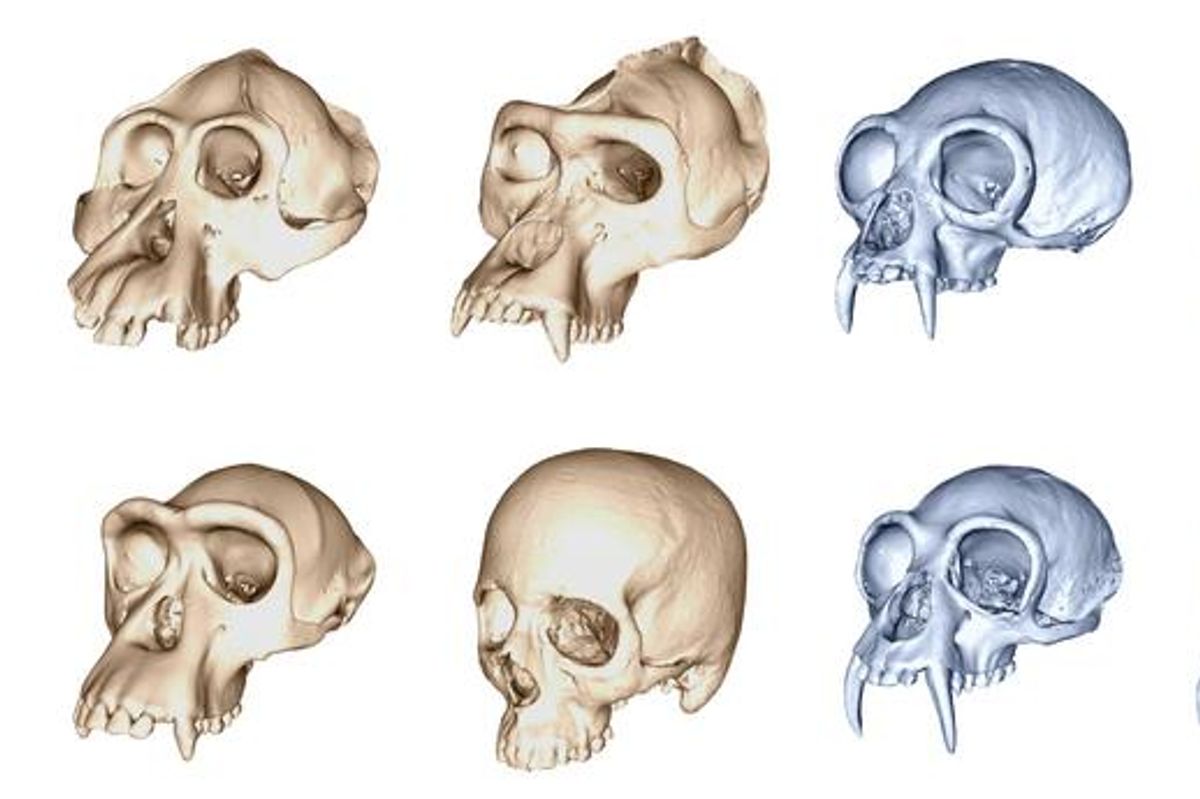Human evolution is a long and winding tale that goes back millions of years, but one aspect of our anatomy shaped up quickly compared to other mammals: our large brains and flat faces. As these distinctive features were catching on in humans, the development of skull structure in other apes dragged behind.
Comparing the skull shapes of humans and various apes, a new study published in Proceedings of the Royal Society B found that we evolved faster than our ape relatives. While apes have retained smaller brains over the years, humans’ gained much larger ones at a comparatively rapid rate, an asset that may have arisen as our ancestors started to live by more complex social structures.
Early Humans Gain Brainpower
Today, humans boast a brain three times larger than that of our ape relatives and extinct ancestors. Primate brains began to gradually bulk up around 2 million years ago with the emergence of the Homo genus, but around 300,000 years ago, early modern humans came onto the scene with brains that would soon take a whole new step toward growth.
Previous research has proposed that as the human family tree branched out, emerging species evolved bigger brains that outshone earlier species. The brain size of the first early modern humans was already significantly larger than that of their predecessors, but brain shape needed further refinement before it could reach its modern form between 100,000 years and 35,000 years ago.
Read More: Culture Could Be Driving Human Evolution and Turning Us Into Superorganisms
Shaping the Modern Human Skull
The new study gauged how human evolution relates to other apes’ evolution by way of variations in skull structure. Researchers accomplished this by looking at 3D virtual models of skulls belonging to seven hominids (“great apes” like humans, gorillas, and chimpanzees) and nine species of hylobatids (“lesser apes” like gibbons).
Hominids and hylobatids diverged around 20 million years ago, with both groups taking different evolutionary trajectories; while diversity in hominids took off, the same cannot be said for hylobatids, which is why many species in the group look similar.
Within the hominid group, though, humans still evolved the fastest. Researchers came to this conclusion after splitting all the species’ skull models into four sections: the upper face, the lower face, the front of the head, and the back of the head. Comparing these sections among each species, they found that humans’ skulls changed about twice as much as expected if there wasn’t some additional factor encouraging additional changes, according to the researchers.
“Of all the ape species, humans have evolved the fastest. This likely speaks to how crucial skull adaptations associated with having a big brain and small faces are for humans that they evolved at such a fast rate,” said lead author Aida Gomez-Robles, an anthropologist at University College London, in a statement. “These adaptations can be related to the cognitive advantages of having a big brain, but there could be social factors influencing our evolution as well.”
The Social Roots of Evolution
Evolution has ultimately given humans a flatter face and a larger brain compared to other apes. This structural difference may be partially linked to social changes in early humans.
After humans, the second fastest evolutionary rate goes to gorillas. While their brains are still small compared to other great apes, the researchers say changes in their skull shape were driven by social selection; gorillas with larger cranial crests on the top of their skulls had a higher social status. Something similar, the researchers suggest, could have caused humans to attain the skull shape we have today.
The rapid evolution of our brains can also be seen at the DNA level with human accelerated regions (HARs), parts of our genome that have evolved rapidly ever since we split from chimpanzees, helping us form complex networks of neurons responsible for our unmatched cognitive abilities.
Read More: Early Humans May Have Used Fires to Smoke Meat One Million Years Ago
Article Sources
Our writers at Discovermagazine.com use peer-reviewed studies and high-quality sources for our articles, and our editors review for scientific accuracy and editorial standards. Review the sources used below for this article:
